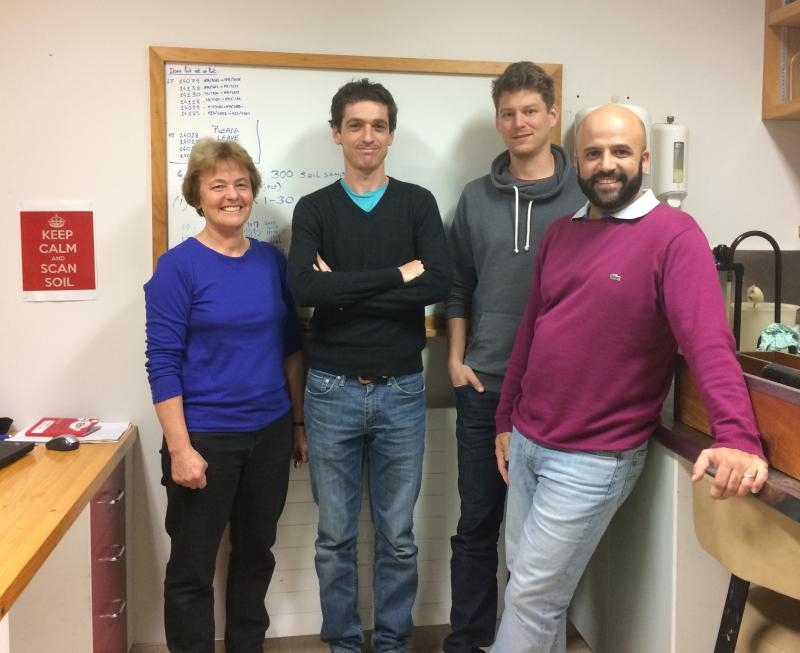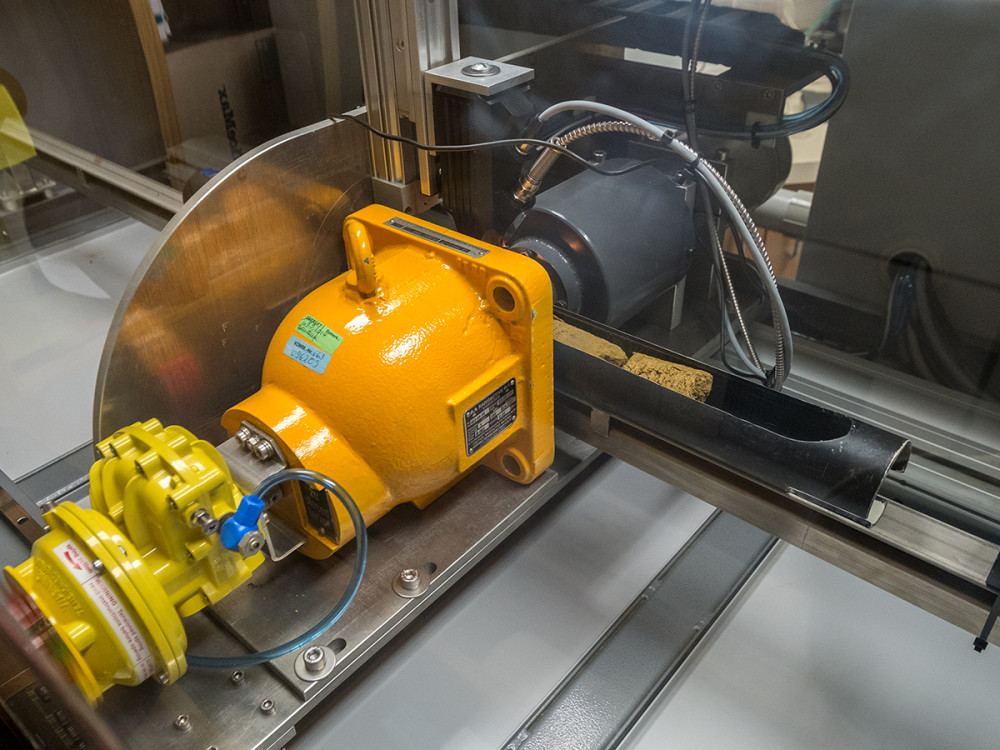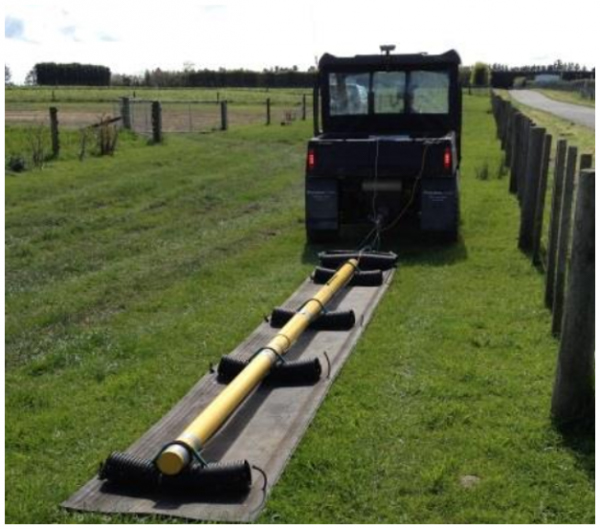Proximal sensing laboratory
Why proximal sensing?

Standard laboratory measurements are a fundamental pillar for the study of soil and its processes. Nonetheless they are often expensive and time consuming, limiting the number of samples that can be analysed. If the research objective is assessing and mapping soil variability, either at farm or national scale, this limitation can preclude a project to fully developed or to reach its objectives.
At Manaaki Whenua, we recognized the importance to capture soil variability and we embarked in the exploration and implementation of new techniques that trade off an extremely high degree of accuracy (typical of laboratory methods) for the potential of analysing a greater dataset, rapidly and at the same cost. These new techniques have been developing since the end of the last century, trying to respond to the increasing urge for cost-effective methods to analyse soil.
Manaaki Whenua's soil quantitative and pedometrics team. From left, Dr Carolyn Hedley, Dr Pierre Roudier, Dr Michael Blaschek and Dr Matteo Poggio.
Different techniques available

The most common approaches to develop sensing techniques are based on the study of the interaction between electric current or electromagnetic (EM) energy with soils. The electromagnetic spectrum ranges from gamma rays (high frequency, high energy and small wavelength) to radio waves (low energy, low frequency and great wavelength), with the visible portion, detected by human eyes, forming a very small portion of the entire EM spectrum.
Several of these EM spectrum portions have been proved to be useful to estimate soil properties: at MW, we possess a gamma-ray attenuation sensor to measure the bulk density of intact core. In simple terms, the active source of gamma rays shines a beam of high energy photons through the material. These photons interact with the material, losing their energy. The denser the material, more photons are attenuated and don’t pass through the material. On the other side of the core, a detector “counts” the photons and from a calibration equation, we can determine the density of the material.
The sensor’s head of the SCANS multi-sensing platform is composed by the active gamma-rays source (on the left), the gamma-rays detector (on the right) and the Analytical Spectral Device (ASD Inc., Boulder, Colorado, United States) high intensity contact probe collecting the spectra (in the centre).
Based on the same theory, a detector can sense the natural radioactive energy originated by the decay of isotopes forming soil minerals. Luckily for us, the energy, released by the minerals is much lower and greater sensors are required to capture it. In the soils, the only elements abundant enough in the minerals, with a long decay period and with enough energy to be detected are potassium (40K), uranium (238U) and thorium (232Th). We installed such a sensor on an ATV and by surveying paddock or fields, we were capable to gather useful insights about areas with different soil lithology and pedogenesis.
Another portion of the EM spectrum widely adopted in soil sensing is at very low frequency and great wavelength (radio waves). The basic concept is to induce (hence the name Electromagnetic Induction [EMI]) an electrical current in the subsurface by applying a EM field close or in contact with the soil surface. The induced current generates in turn, a secondary and weaker EM field which can be measured and whose intensity depends primarily on soil characteristics such as salinity, water content and clay content. Due to the operational easiness, this method has been extensively adopted to rapidly survey field, identifying homogeneous areas based on water content or soil texture, or determine salinity issues. MW shares a EMI instrument with Massey University for soil survey.
Manaaki Whenua ahead of the game in New Zealand

The application of diffuse reflectance spectroscopy (DRS) to soil analysis has received particular interest and attention in the last two decades and important organizations such as the United Nation's Food and Agriculture Organisation (FAO) have recognized its potential in soil analysis. This methodology has a long history and its first application to soil science dates back to end of the 1950s.
Manaaki Whenua began to investigate possible applications more than 10 years ago. We now have at our disposal an array of sensors, unique in New Zealand. The theory behind DRS is intuitive and can be explain by colours association: in front of a soil profile with a dark brown top soil, we are inclined to associate this particular aspect to abundance of organic material or high water content. This is because these soil components tend to absorb the light and reflect minimal part of it. Similarly, in front of a soil horizon with white dots or a strong red colours, we suspect the presence of carbonates or iron minerals, respectively.
On-the-go electromagnetic induction (EMI) survey conducted with a Dualem (Milton, Ontario, Canada) sensor. Due to the inside configuration of the sensor, the data collected referred to the soil profile to up 6m depth.
This occurrence is explained by the fact that the incident light is absorbed by the soil materials and just specific wavelengths, corresponding to white and red colours (for carbonates and iron oxides, respectively) are reflected. In more scientific terms, each molecule vibrates at a specific frequency due to the elements that form it. When the incident light radiates the soil profile, the light frequencies corresponding to the molecules frequencies present in the soil are partially absorbed. Combining the amount of light reflected for each wavelength, we obtain a unique spectral signature or “fingerprint”, resulting from the molecules of soil components.
But while our eyes are capable to perceive the very limited visible (Vis) portion of the EM spectrum (around 300 wavelengths, from 400 nm or violet colour, to 700 nm or red colour), the DRS sensor can detect a broader portion of EM that usually includes near infrared (NIR, 700-2500 nm) and middle infrared (MIR, 2500-16600 nm). These EM portions contain the fundamental information about molecules, providing a spectral signature or fingerprint that is easier to interpret. To scan the soil sample and collect the spectra, the sensor takes less than a minute and the samples does not require any pre-processing.
In the MW laboratories, we can use two VisNIR spectrometers, one connected to the SCANS sensing platform for intact core and one for dried and sieved samples, and a MIR spectrometer. Accessing the extensive soil archive with associated soil database, we have been scanning soil samples and successively building calibration models to estimate properties such as organic carbon, total nitrogen, soil texture, available water content and pH from the soil samples.